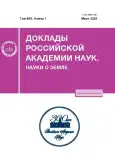UNPRECEDENTED DURATION OF THE 2020 ANTARCTIC OZONE DEPLETION
- Authors: Zuev V.V.1, Savelieva E.S.1, Pavlinsky A.V.1, Sidorovski E.A.1
-
Affiliations:
- Institute of Monitoring of Climatic and Ecological Systems of the Siberian Branch of the Russian Academy of Sciences
- Issue: Vol 509, No 1 (2023)
- Pages: 120-124
- Section: GEOECOLOGY
- Submitted: 14.10.2023
- Published: 01.03.2023
- URL: https://journals.rcsi.science/2686-7397/article/view/135762
- DOI: https://doi.org/10.31857/S2686739722602319
- EDN: https://elibrary.ru/TJECZJ
- ID: 135762
Cite item
Full Text
Abstract
In this work, we show a trend of lengthening the period of high intensity of the Antarctic polar vortex in late spring and early summer (November–December), which has been traced over the past 30 years. This trend is observed both in the dynamics of the main characteristics of the polar vortex (vortex area and wind speed along the vortex edge) and in the Antarctic ozone hole area. A clear manifestation of this is the polar vortex dynamics in 2020, when there were unusually high wind speeds along the vortex edge throughout the entire period of its existence and record values of vortex area and ozone hole area from mid-November to December. In addition, the polar vortex existed until the last week of December, which is an unprecedented case. To analyze the Antarctic polar vortex dynamics, we used the vortex delineation method by geopotential values determined from the maximum temperature gradient and maximum wind speed characterizing the vortex edge.
About the authors
V. V. Zuev
Institute of Monitoring of Climatic and Ecological Systems of the Siberian Branch of the Russian Academy of Sciences
Author for correspondence.
Email: vzuev@list.ru
Russian Federation, Tomsk
E. S. Savelieva
Institute of Monitoring of Climatic and Ecological Systems of the Siberian Branch of the Russian Academy of Sciences
Email: vzuev@list.ru
Russian Federation, Tomsk
A. V. Pavlinsky
Institute of Monitoring of Climatic and Ecological Systems of the Siberian Branch of the Russian Academy of Sciences
Email: vzuev@list.ru
Russian Federation, Tomsk
E. A. Sidorovski
Institute of Monitoring of Climatic and Ecological Systems of the Siberian Branch of the Russian Academy of Sciences
Email: vzuev@list.ru
Russian Federation, Tomsk
References
- Solomon S. Stratospheric ozone depletion: a review of concepts and history // Rev. Geophys. 1999. V. 37. № 3. P. 275–316.
- Newman P.A., Kawa S.R., Nash E.R. On the size of the Antarctic ozone hole // Geophys. Res. Lett. 2004. V. 31. № 21. P. L21104.
- Варгин П.Н., Никифорова М.П., Звягинцев А.М. Изменчивость антарктической озоновой аномалии в 2011–2018 гг. // Метеорология и гидрология. 2020. № 2. С. 20–34.
- Сибир Е.Е., Радионов В.Ф., Русина Е.Н. Результаты многолетних наблюдений за общим содержанием озона в Антарктиде и над акваториями Атлантического и Южного океанов // Метеорология и гидрология. 2020. № 3. С. 33–43.
- Waugh D.W., Randel W.J., Pawson S., Newman P.A., Nash E.R. Persistence of the lower stratospheric polar vortices // J. Geophys. Res. 1999. V. 104. № 22. P. 27191–27201.
- Zuev V.V., Savelieva E. The role of the polar vortex strength during winter in Arctic ozone depletion from late winter to spring // Polar Sci. 2019. V. 22. P. 100469.
- Waugh D.W., Sobel A.H., Polvani L.M. What is the polar vortex and how does it influence weather? // Bull. Amer. Meteor. Soc. 2017. V. 98. № 1. P. 37–44.
- Stenchikov G., Robock A., Ramaswamy V., Schwarzkopf M.D., Hamilton K., Ramachandran S. Arctic Oscillation response to the 1991 Mount Pinatubo eruption: Effects of volcanic aerosols and ozone depletion // J. Geophys. Res. 2002. V. 107. № 24. P. ACL28.
- Zuev V.V., Savelieva E. The cause of the spring strengthening of the Antarctic polar vortex // Dynam. Atmos. Oceans. 2019. V. 87. P. 101097.
- Hersbach H., Bell B., Berrisford P., Hirahara S., Horányi A., Muñoz-Sabater J., Nicolas J., Peubey C., Radu R., Schepers D., Simmons A., Soci C., Abdalla S., Abellan X., Balsamo G., Bechtold P., Biavati G., Bidlot J., Bonavita M., de Chiara G., Dahlgren P., Dee D., Diamantakis M., Dragani R., Flemming J., Forbes R., Fuentes M., Geer A., Haimberger L., Healy S., Hogan R.J., Hólm E., Janisková M., Keeley S., Laloyaux P., Lopez P., Lupu C., Radnoti G., de Rosnay P., Rozum I., Vamborg F., Villaume S., Thépaut J.-N. The ERA5 global reanalysis // Q. J. Roy. Meteor. Soc. 2020. V. 146. № 729. P. 1–51.
- Zuev V.V., Savelieva E. Antarctic polar vortex dynamics during spring 2002 // J. Earth Syst. Sci. 2022. V. 131. № 2. P. 119.
- Zuev V.V., Savelieva E. Antarctic polar vortex dynamics depending on wind speed along the vortex edge // Pure Appl. Geophys. 2022. V. 179. № 6–7. P. 2609–2616.
- Holton J. An Introduction to Dynamic Meteorology. 4th Edition. California: Academic Press, 2004. 535 p.
- Newman P.A., Nash E.R. The unusual Southern Hemisphere stratosphere winter of 2002 // J. Atmos. Sci. 2005. V. 62. № 3. P. 614–628.
- Safieddine S., Bouillon M., Paracho A.-C., Jumelet J., Tencé F., Pazmino A., Goutail F., Wespes C., Bekki S., Boynard A., Hadji-Lazaro J., Coheur P.-F., Hurtmans D., Clerbaux C. Antarctic ozone enhancement during the 2019 sudden stratospheric warming event // Geophys. Res. Lett. 2020. V. 47. № 14. P. e2020GL087810.
- Cracknell A.P., Varotsos C.A. The Antarctic 2006 ozone hole // Int. J. Remote Sens. 2007. V. 28. № 1. P. 1–2.
- Stone K.A., Solomon S., Kinnison D.E., Mills M.J. On recent large Antarctic ozone holes and ozone recovery metrics // Geophys. Res. Lett. 2021. V. 48. № 22. P. e2021GL095232.
- Zuev V.V., Savelieva E. The cause of the strengthening of the Antarctic polar vortex during October–November periods // J. Atmos. Sol.-Terr. Phys. 2019. V. 190. P. 1–5.
Supplementary files












